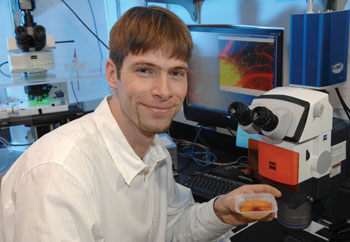
Andries Zijlstra, Ph.D., is studying ways to block tumor cells’ ability to metastasize. (photo by Neil Brake)
Study seeks to halt cancer’s wandering ways
The spread of tumor cells to various organs — metastasis — is the most deadly aspect of cancer.
New findings suggest that it might be possible to stop this lethal behavior by making cancer cells “stick” to the primary tumor.
Andries Zijlstra, Ph.D., and colleagues reported in the March issue of Cancer Cell that an antibody targeted to a molecule known as CD151 prevents cancer cells from leaving the original tumor and blocks metastasis.
“In essence, the cancer cell is grabbing on to the matrix (the structural material between cells) and not letting go,” said Zijlstra, assistant professor of Pathology and Cancer Biology.
Zijlstra initiated the studies during his postdoctoral training in the laboratory of James Quigley, Ph.D., at The Scripps Research Institute.
The team was looking for antibodies that could stop tumor cell metastasis in a living chick embryo, a model used to study metastasis. They found an antibody that worked well and determined that it targeted CD151, a protein known to associate with integrins — cell surface proteins responsible for adhesion to the matrix.
The researchers confirmed that CD151 was expressed in a variety of human tumors — suggesting that it may have clinical relevance — and then set about trying to understand how this molecule participated in metastatic events.
Other studies had described CD151 as a “pro-migratory” molecule, so it made sense that an antibody directed against it might work by blocking cell movement. And indeed, tumor cells in chick embryos treated with the antibody to CD151 appeared tightly clustered, whereas those in embryos treated with a control antibody readily moved to other sites.
But the early studies were static, and Zijlstra and his colleagues wanted to watch what was happening in the living tissue, in real time. To do this, they developed a method called intravital imaging for the chick embryo model. They were surprised to see that tumor cells in antibody-treated embryos could “move” around a fixed point, but they couldn't detach from that point and move away from the tumor.
“That was a very unusual and unexpected finding, and it demonstrated to us that we could immobilize cancer cells by promoting adhesion to the matrix,” Zijlstra said.
The antibody treatment prevented metastasis of two different types of aggressive human cancer cells, epidermoid carcinoma and fibrosarcoma, supporting the notion that the immobilizing machinery may be common to different cancers.
“I think these findings offer a breath of hope clinically, because we're seeing that tumor cells are not so abnormal that they don't retain the ability to restrain themselves,” Zijlstra said. “By triggering this CD151 protein, we can promote immobility and thereby prevent metastasis.”
Zijlstra is now working to discover the molecular mechanisms that mediate this cellular immobility. He knows that the antibody to CD151 enhances the formation of “adhesion complexes” — multiple proteins that work together to adhere cells to the matrix.
“We think that in the presence of the antibody, the cancer cells are able to form these adhesive structures, but then they can't disassemble them, so they're stuck,” he said.
Cellular immobility, he points out, is natural in normal tissues — once cells form tissues, they don't pick up and move elsewhere.
“Cancer cells have lost this inherent immobility, and we're somehow reinstating it,” Zijlstra said.
The findings also support the idea that cells actively move out of the primary tumor to colonize new sites rather than being passively shed into the bloodstream — an ongoing debate about mechanisms of metastasis.
“At the very minimum, the cell has to actively detach from its microenvironment and enter the vasculature,” Zijlstra said. “If it can't do that, it can't spread.”
The National Institutes of Health and the American Heart Association supported the research.













